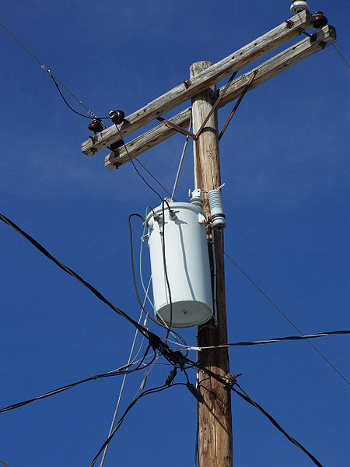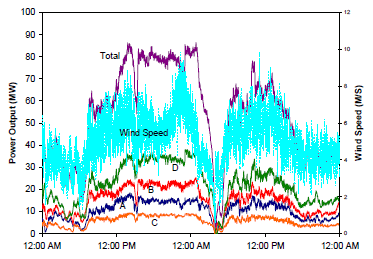Flywheel Energy Storage
July 21, 2011
In a
previous article (Green Braking, October 20, 2010), I discussed the use of
flywheels as a means of harvesting braking energy in vehicles. Flywheel technology has been with us for millennia, going back to the
potter's wheel. The energy
E stored in a flywheel is given by the simple equation,
E = ½ I ω2
where
I is the
moment of inertia of the rotating body and
ω is the
angular velocity, usually expressed in
radians per second. If the rotating body is a solid cylinder, the moment of inertia is given as
I = ½ m r2
where
m is the rotor mass, and
r is its radius.
These equations reveal that you can store a lot of energy in a flywheel if it's large and spins very fast. If you want to do this, you need to keep several things in mind:
• To prevent the flywheel from losing energy by heating the air around it, it needs to operate in a vacuum.
• Since the flywheel material will be under considerable tensile stress, it should be fabricated from a high strength material, preferably one that is not prone to fracture.
• Since flywheels spin up, then down, repeatedly, there the possibility of material fatigue that will lead to fracture, so flywheels should be enclosed in a protective shroud to contain flying schrapnel.
Because of its manifold advantages, the
alternating current electrical power distribution system of
George Westinghouse won the
War of Currents against
Thomas Edison's direct current. The biggest advantage of alternating current is that
transformers can be used to convert low
current, high
voltages to higher current, low voltage. This is important when conducting electrical power over long distances, since there is less loss in low current lines. Power loss in a wire of
resistance R is
I2R, where
I is the current.

A typical US residential power distribution transformer mounted on a utility pole.
This transformer sits on a pole at the left of my house as a reminder that we live in a culture that's evolved technically, but not aesthetically.
Photo by author (Via Wikimedia Commons)
The
power line frequency in the US is 60
Hz. This frequency was
selected by
Westinghouse Electric as a compromise for operating
induction motors and
lighting on the same electrical circuit. Too low a frequency would cause a noticeable flicker in lights, and too high a frequency increases the
impedance of
inductance circuits. Other countries use a 220-240 volt, 50 Hz system, and not the 100-120 volt, 60 Hz system used in the US. The essential fact is that once a frequency is defined, everything from the transformers on utility poles to refrigerator motors are designed to give best performance at that frequency.
A recent article in the
IEEE Spectrum reviews the use of flywheels as a means of regulating the frequency of
electrical generators that are used to supply electrical power.[1] Just as an automobile will slow as it climbs a hill and speed up while going downhill, the same thing happens to electrical generators in response to changing consumer power demand during the day and supply generators being added or removed from the electrical grid. As reported in Spectrum, utility frequency regulation, which is becoming more important as non-predictable power such as
photovoltaic and
wind power is added to our power palette, is no small market. It was nearly half a billion dollars in 2010.[1]

Performance of a four-section Midwestern wind plant over a two day interval. Wind speed is also shown.
From an Oak Ridge National Laboratory Report.[2]
Such control was somewhat easier in the past, since it could be achieved by adjusting the mechanical speed of generators, but you can't tweak wind speed or passing clouds to give more power. In the case of an extremely variable supply, power must often come from a stored source, or be easily dumped into a storage device. Flywheels are like
capacitors for the AC power grid. As always, there are competing technologies, such as
electrochemical batteries. The only technologies that are viable in this frequency leveling application are ones that can respond in seconds.
The problem with batteries, according to the Spectrum article, is that they will wear out with the constant charging and discharging.
Beacon Power Corporation has a twenty
megawatt flywheel facility in
Stephentown, New York, with more than 160
metric ton sized
carbon fiber composite flywheels spinning hundreds of time per second.[1,3] Beacon says that its flywheels have a twenty year life expectancy in the utility frequency-leveling application.[1] You can view an "
Environmental Assessment" for this type of a facility in Ref. 4.
The
US Department of Energy's Pacific Northwest National Laboratory has been exploring a different type of control in which commands are sent to homes to turn off heating elements in
clothes dryers and
water heaters. How much load capacity is there in such devices? The water heater in my house uses natural gas. Although our clothes dryer is electric, I wouldn't want to head to the supermarket in wet clothing during a
New Jersey winter!
References:
- Peter Fairley, "Flywheels Keep the Grid in Tune," IEEE Spectrum, July, 2011.
- Brendan J. Kirby, "Frequency Regulation Basics and Trends," Oak Ridge National Laboratory, Report No. ORNL/TM-2004/291, December 2004
- Beacon Power's New York flywheel power plant fully operational, Composites World, June 6, 2011.
- U.S. Department of Energy, National Energy Technology Laboratory, "Draft Environmental Assessment For The Beacon Power Corporation Flywheel Frequency Regulation Plant, Chicago Heights, Illinois," Report No. DOE/EA-1753RD, October 2010
Permanent Link to this article
Linked Keywords: Flywheel; potter's wheel; flywheel energy storage; moment of inertia; angular velocity; radians per second; vacuum; tensile stress; fracture; material fatigue; Kevlar; protective shroud; schrapnel; alternating current; electrical power; George Westinghouse; War of Currents; Thomas Edison; direct current; transformer; current; voltage; resistance; aesthetics; Wikimedia Commons; power line frequency; hertz; Hz; utility frequency; Westinghouse Electric; induction motor; lighting; impedance; inductance; IEEE Spectrum; electrical generator; photovoltaic; wind power; Oak Ridge National Laboratory; capacitor; electrochemical battery; Beacon Power Corporation; megawatt; Stephentown, New York; metric ton; carbon fiber composite; environmental impact assessment; US Department of Energy; Pacific Northwest National Laboratory; clothes dryer; water heater; New Jersey.